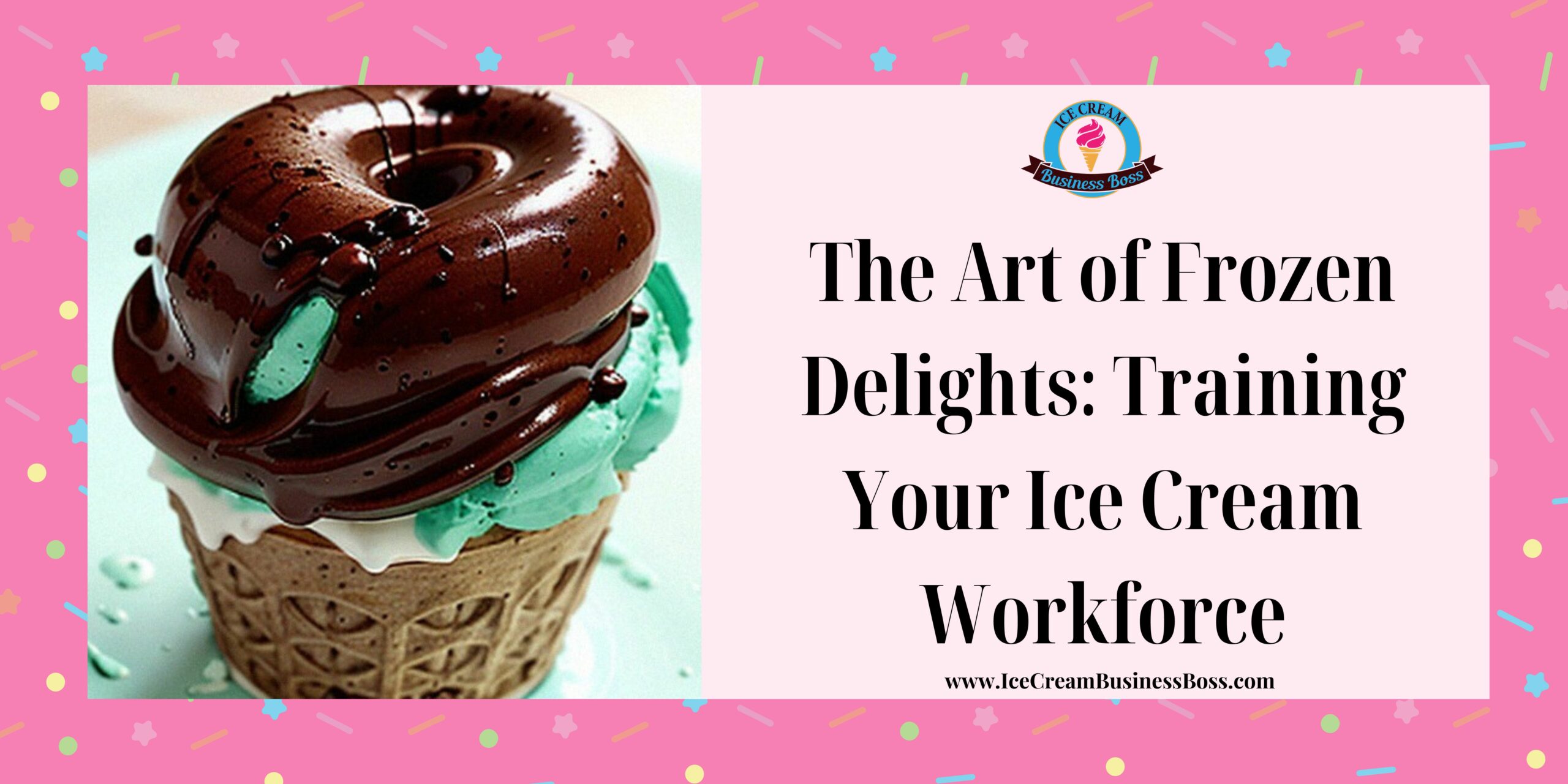There is a universe beyond the ingredients and recipes that adds greatly to the growth of an ice cream business in the delicious world of ice cream, where tastes dance and textures, please. What’s the secret ingredient? A workforce that is well-trained and motivated. From making the perfect scoop to providing friendly customer service, the expertise of your employees may make or break the reputation of your ice cream shop.
The best way to train employees in your ice cream business is by providing comprehensive instructions on ice cream preparation, hygiene, and customer service. Offer hands-on demonstrations, interactive role-playing, and regular feedback to ensure consistent product quality and exceptional customer experiences.
In this article, we delve into the complexities of employee training in the ice cream industry, looking at tactics that ensure not only delightful frozen delights but also outstanding client experiences. Whether you’re a seasoned ice cream entrepreneur or just starting, the tips presented here will help you churn out not just ice cream, but achievement as well.
Comprehensive Instructions for Ice Cream Preparation
A thorough understanding of the complexities involved in ice cream preparation is a crucial qualification for employees working in the field of creating enticing ice cream treats. The first step in teaching someone how to make a delicious frozen dessert is to familiarize them with the fundamental aspects of ingredient selection and accurate measurement.
Understanding how important high-quality components are in determining the final product’s flavor and texture is essential to this skill. The secret to creating ice cream that tantalizes the taste buds and enchants the senses is the harmonic combination of these ingredients. Employees are given the information to improve their works of art to a degree of perfection by clarifying the relevance of this idea.
Untangling the subtleties of mixing and churning processes is the next step. This detailed tutorial highlights the transformational power of deft blending, which supports the creation of the desired creamy texture. Studying the physics of churning explains how to achieve the ideal consistency, guaranteeing that the final product radiates the distinctive smoothness of fine ice cream.
The alchemy of flavor combinations emerges as a crucial component outside of the realm of technique. Employees must learn to navigate the complex dance between sweet and savory, fruity and decadent, and the symphony of flavors that can be orchestrated. This knowledge enables them to create a variety of flavors that appeal to a variety of clients’ palates as well as their preferences.
While theoretical understanding serves as the foundation, practice sessions with experienced staff members work as the furnace for honing these talents. Employees have the opportunity to watch theories come to life as delicious realities thanks to the experience dimension. Working alongside experts in the field also fosters a sense of confidence and camaraderie, creating a supportive environment for learning new skills.
Prioritizing Hygiene Practices

Maintaining perfect cleanliness standards becomes a clear-cut necessity in the complex web of the food sector, especially when it comes to dairy-centric foods like ice cream. The crux of this requirement is to provide your personnel with thorough training that covers the nuances of efficient handwashing, meticulous equipment sanitization, and the conscientious use of gloves and hairnets.
The development of good handwashing habits is the first step in the development of hygiene in the dairy sector, where the transformation of raw components into exquisite frozen confections takes place. Employees build a strong barrier against potential pollutants and nurture a shield that maintains the integrity of the finished product by developing the skill of thorough hand cleaning.
Beyond this, a crucial act in this symphony of cleanliness is the drama of equipment sanitization. A thorough education in the techniques for thoroughly cleaning equipment and utensils not only improves ice cream quality but also protects the health and well-being of customers who indulge in these frozen treats. Your dedication to providing a product that is enticing and pure is demonstrated by the meticulous orchestration of these cleanliness methods.
The skillful use of hairnets and gloves becomes important as extra protection against harmful pollutants. This two-pronged strategy highlights the complexity of maintaining hygiene and strengthens the barrier against any accidental entry of outside elements.
Cross-contamination is perhaps the most nefarious foe in the field of hygiene. It is crucial to inform your staff of this looming hazard. They will be more equipped to protect your company’s reputation if you inform them of the catastrophic damage that cross-contamination can do to the pure purity of the ice cream.
Check out this article to learn how you can start your own ice cream truck business.
Mastering Customer Service
In the competitive business world, providing great customer service is the cornerstone of growth. This rule holds for many industries, including the ice cream sector. The path to accomplishment in this area entails strategically training your staff to make them ambassadors of friendliness and warmth in every client engagement.
The development of a kind and welcoming demeanor, a talent that emanates an inviting atmosphere and welcomes customers into a world of exquisite ice cream experiences, is at the core of this attempt. This transforming characteristic creates the conditions for sincere friendships and reverberates as proof of your dedication to their fulfillment.
Another essential component of the art of client connection is active listening. By improving this ability, your staff members learn the subtleties of consumer preferences, giving them the toolkit they need to provide individualized recommendations and reactions. When attentive listening and customized responses work together, an immersive experience is created that goes beyond simple transactions.
Role-playing scenarios become a crucial tool for preparing your team to handle a range of customer encounters, from the simple to the complicated. Employees can hone their approach through these practice contacts and become better equipped to handle complaints, make insightful suggestions, and meet a variety of needs.
Although there are many different techniques and skills, patience and a cheerful attitude are of the utmost importance. With its diverse clientele, the ice cream industry requires unwavering composure. Unhurried conversations are made possible by patience, which promotes a culture where clients feel heard and respected. A positive outlook can also weave the threads of routine transactions into the fabric of enduring connections.
Hands-On Demonstrations for Practical Learning

In the quest for mastery, theory acts as a compass, but real-world experience—particularly in the complex world of ice cream preparation—emerges as the true North. Given this, it is crucial to plan engaging hands-on training that enables staff members to go beyond the confines of theory and immerse themselves in the tangible world of ice cream creation.
Employees are given the chance to not only comprehend but also internalize the complexities inherent in the ice cream-making process through these hands-on experiences. The rhythm of churning, the alchemy of blending materials, and the craft of creating the ideal texture all materialize into practical acts, resulting in a profound comprehension that goes beyond what is written on paper.
These lessons have an influence that goes beyond theory and involves boosting confidence. A sense of empowerment emerges as workers engage in the physical practice of their craft. Their behaviors reflect this renewed assurance, constructing a fabric of assurance that runs through each stage of making ice cream. The outcome? is a more reliable and improved product quality that consistently pleases your customers’ palates.
It is impossible to overstate the importance of experienced hands in this educational process. The supervision of these sessions by experienced trainers or senior staff acts as a guiding light. Their attentive observation and skillful corrections offer quick feedback, turning mistakes into teaching moments and creating an atmosphere that encourages growth.
The idea of learning by doing is supported by the interaction between practical sessions and professional supervision. It fosters knowledge that goes beyond what can be learned from lectures and textbooks. The movements of churning, mixing, and molding transform the hands into carriers of knowledge, and the feelings that go along with them deeply imprint the subtleties of the trade in the mind.
Interactive Role-Playing for Real-World Scenarios
Role-playing exercises become an excellent tool for immersing personnel in the dynamic theater of customer service and problem-solving, similar to a training field where the possibilities of real-world events are laid out in front of them. By allowing people to embody the roles they play in the customer journey and develop replies that mimic the subtleties of real-world encounters, this experiential method goes beyond the realm of theory.
Imagine a busy ice cream shop during rush hour, which is a situation that regularly puts even the most experienced personnel to the test. Employees might assume the role of service providers dealing with a busy crowd by simulating this high-pressure environment. Their capacity to remain calm in the face of chaos is fostered by the immersive experience, which unfolds as a maze of time-sensitive choices, lightning-fast exchanges, and the delicate ballet of order fulfillment.
The ability to placate a displeased customer is equally important. Role-playing games can cleverly simulate this scenario, allowing staff members to assume the roles of both the offended customer and the staff member tasked with finding a solution. Knowledge of consumer emotions is fostered by this dynamic role reversal, which also serves as a testing ground for the skillful art of assuaging worries while upholding the integrity of the business.
Role-playing can transform employees into gastronomes in the area of flavor ideas. They gain a deep awareness of flavor characteristics and inventive mixtures when given the responsibility of creating customized suggestions based on consumer preferences. This improves their capacity to provide customized experiences and fosters a greater understanding of the wide range of tastes.
Beyond these particular instances, there is a more general goal: improving adaptability and efficient reaction. Role-playing develops an inbuilt flexibility in participants, enabling them to quickly adjust their strategies in response to the shifting circumstances of actual scenarios. Because of the experiential character of these exercises, participants develop agility that enables them to maneuver the choppy waters of customer service with skill and assurance.
Check out this article to learn more about the rolled ice cream business.
Regular Feedback for Continuous Improvement

Feedback appears as an essential thread in the tapestry of personal and professional development, guiding the path through the fabric of growth. Its power comes from its dual nature, which may both highlight opportunities for improvement and recognize achievements. A well-rounded feedback loop that is established within your workforce fosters motivation and engagement while also defining a culture of continual learning.
Performance reviews of employees are the cornerstone of this feedback ecosystem. These assessments carried out fairly and openly, serve as a mirror for people to see their strengths and pinpoint areas that need improvement. This helpful critique acts as a compass, pointing people in the direction of improvement by highlighting elements that could otherwise go unnoticed. Recognition and criticism coexist in a symbiotic dance that reflects the entire nature of progress and encourages a nuanced and balanced approach to development.
The function of recognition in this paradigm is equally important. Recognizing employees’ accomplishments and efforts resonates as a concrete example of their worth to the company. When their devotion is recognized, a sense of being respected and appreciated grows, serving as an essential engagement cornerstone. An employee’s motivation to perform at their highest level is increased by this act of appreciation since they know that their contributions are valued and noticed.
These factors come together to create a culture that values motivation and ongoing development. Employees are motivated to take on new projects with excitement when they are aware that their growth is fostered and their accomplishments are appreciated. This innate drive serves as a compass, guiding people toward becoming a more capable and dedicated workforce.
A feedback-rich atmosphere also strengthens the relationship between the employer and the employee. When management makes an effort to mentor and acknowledge employees, it fosters loyalty and a sense of community. This investment has a lasting impact not only on productivity but also on the development of an organization that people are pleased to be a part of.
Frequently Asked Questions
Why is extensive training necessary for personnel in the ice cream industry?
Comprehensive training is required because it provides personnel with the knowledge and skills they need to create high-quality ice cream, maintain hygienic requirements, and deliver exceptional customer service. It assures constant product quality and improves client experiences, resulting in increased corporate growth.
What are the advantages of hands-on demonstrations in staff training?
Employees can learn ice cream preparation techniques in a controlled environment with hands-on demonstrations. This hands-on experience allows them to grasp the complexities of the process, gain confidence, and maintain a constant level of product quality. Experienced supervisors can offer real-time guidance, which improves the learning process.
How important is regular feedback in staff training?
Employee growth relies heavily on regular feedback. It identifies opportunities for improvement and recognizes achievements. This promotes a culture of ongoing learning and motivation, resulting in a more engaged and skilled staff. Feedback also assists employees in aligning their performance with the company’s goals and consumer expectations.
The information provided by IceCreamBusinessBoss.com (“The Site”) is for general informational purposes only. All information on the Site is provided in good faith, however, we make no representation or warranty of any kind, express or implied, regarding the accuracy, adequacy, validity, reliability, availability, or completeness of any information on the Site. Under no circumstance shall we have any liability to you for any loss or damage of any kind incurred as a result of the use of the Site or Reliance on any information provided on the Site. Your use of the Site and your reliance on any information on the Site is solely at your own risk. This blog post is for educational purposes only and does not constitute legal advice. Please consult a legal expert to address your specific needs. Terms and Conditions.

Hi! I am Shawn and I am a happy individual who happens to be an entrepreneur. I have owned several types of businesses in my life from a coffee shop to an import and export business to an online review business plus a few more and now I create online ice cream/gelato business resources for those interested in starting new ventures. It’s demanding work but I love it. I do it for those passionate about their business and their goals. That’s why when I meet a ice cream/gelato business owner, I see myself. I know how hard the struggle is to retain clients, find good employees and keep the business growing all while trying to stay competitive.
That’s why I created Ice Cream Business Boss: I want to help ice cream and gelato business owners like you build a thriving business that brings you endless joy and supports your ideal lifestyle.

